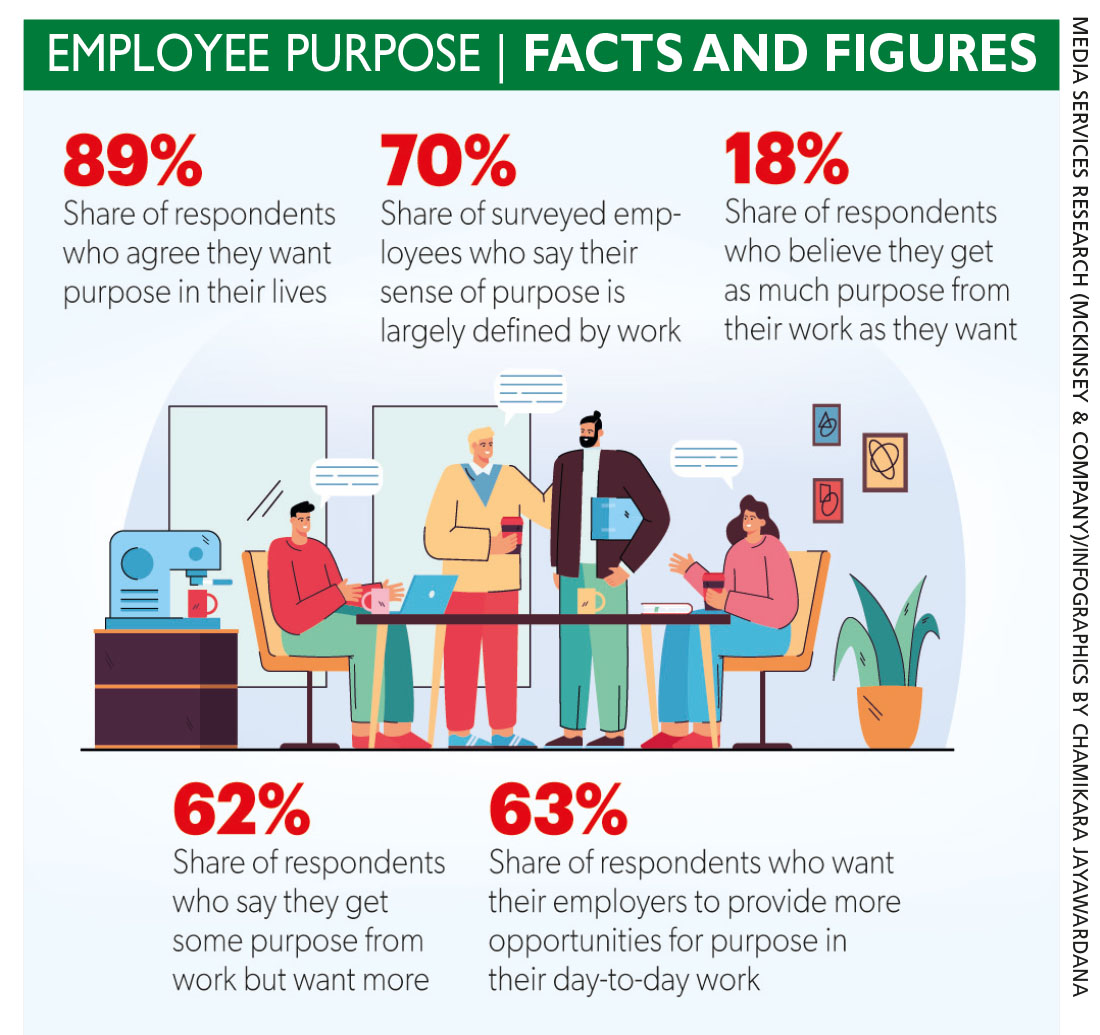CORPORATE SUSTAINABILITY
PURPOSE HIERARCHY
The advantage of a purposeful
business – Kiran Dhanapala
The concept of purpose is increasingly present in various contexts such as individual, human resources, spiritual and of late, the corporate world. This shift of spiritual and personal wellbeing into the business arena demonstrates the reality that organisations are human; and mere mechanisa-tion or advanced AI cannot change that fundamental truth.
 For instance, McKinsey & Company researched individual employee purpose recently and revealed some significant findings.
For instance, McKinsey & Company researched individual employee purpose recently and revealed some significant findings.
Its survey of over 1,000 American employees has global implications especially during pandemic times when many workers question their purpose, and shift to making choices that are better oriented to a renewed sense of purpose in work and life.
It has been reported that employees who live out their purpose are more productive, resilient, engaged, loyal and healthier – and will remain for longer with their employer. Conversely, less satisfied staff have lower work and life outcomes; less engagement, satisfaction and excitement at work; as well as less energy.
Living and working with purpose benefits both individuals and the organisations they work for, given that 70 percent of respondents say their purpose is defined by their work. Therefore, work is an important part of the larger purpose equation.
T here is however, a purpose hierarchy gap in organisations – i.e. executives and higher management live more on purpose at work than their non-executive counterparts. The survey found the gap to be 85 percent compared to 15 percent. Front line staff often reports fewer opportunities
here is however, a purpose hierarchy gap in organisations – i.e. executives and higher management live more on purpose at work than their non-executive counterparts. The survey found the gap to be 85 percent compared to 15 percent. Front line staff often reports fewer opportunities
for purpose at work.
Interestingly, staff who are parents were also more reliant on work for purpose – given their relative lack of time and more future oriented thinking.
To leverage these advantages, an organisation needs to strengthen purpose in its employees’ work lives. Creating purposeful work is complex since workers don’t usually wear their purpose on their sleeves.
This means that corporate leaders need to find out what drives employees through dialogue, and meet staff at all levels to find out where they are and what can be done to optimise their sense of fulfilment.
A sustainability strategy plays a significant role in creating purpose at work and aligning corporate with individual purpose.
It’s the one thing that an organisation has direct control over and can create a meaningful influence as regards purpose. It can give staff meaningful ways to contribute to society with an employer that sees itself as a contributor to a sustainable economy and society.
Leaders must share the big picture of their corporate sustainability strategy and its implications for purposeful business. They must outline key factors that were taken into account in designing the strategy, assumptions that were made, targets and timelines, initiatives envisaged, calls for further ideas etc.
These need to be communicated; and in turn, managers need to inform front liners throughout the organisation.
There needs to be dialogue rather than a spate of monologues in rolling out a meaningful sustainability strategy because there’s nothing more damaging than talk and no action or lip service to a strategy. It leads to cynicism and causes more harm than doing nothing.
Recruitment will also change by factoring in the identification of close matches of individuals to corporate purpose. Hiring employees who resonate with specific segments of a sustainability strategy or targets results in greater benefits to the organisation.
Furthermore, it helps to integrate communication with purpose in staff orientations, performance appraisals, exit interviews and so on. In the future, and with skill shortages, the fight for talent will be determined by purpose.
The World Business Council for Sustainable Development’s Vision 2050 research has shown that business resilience is about adopting behaviour and actions that enable an enterprise to be adaptable. Emphasising purpose and values in leadership allows for adaptability, and it will help steer the corporate world through an increasingly volatile decade.



